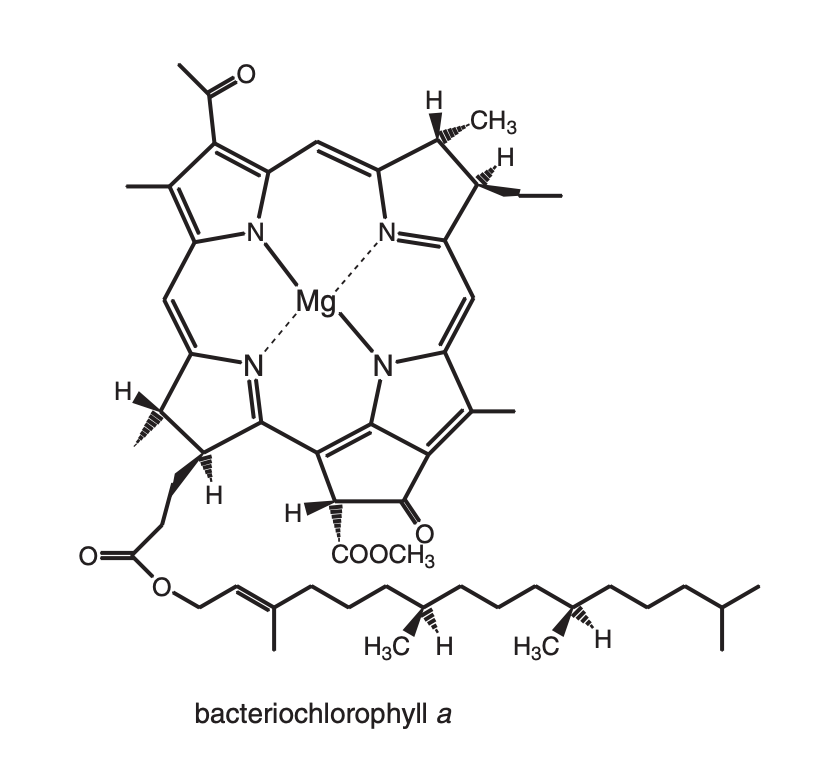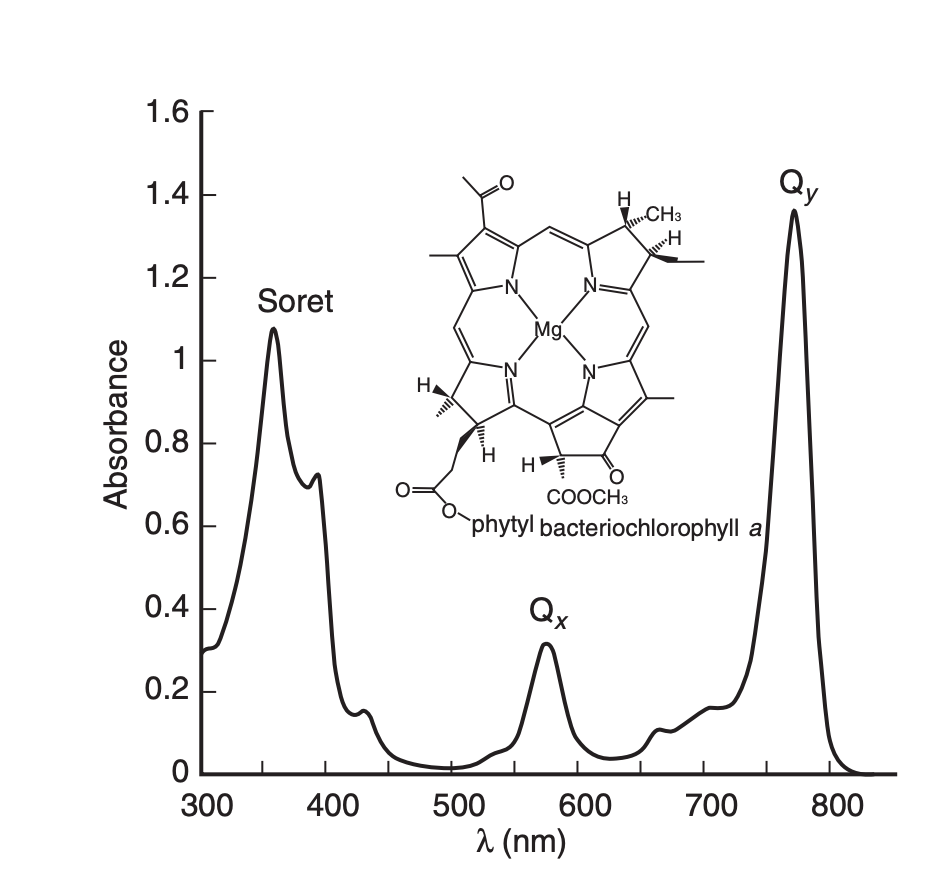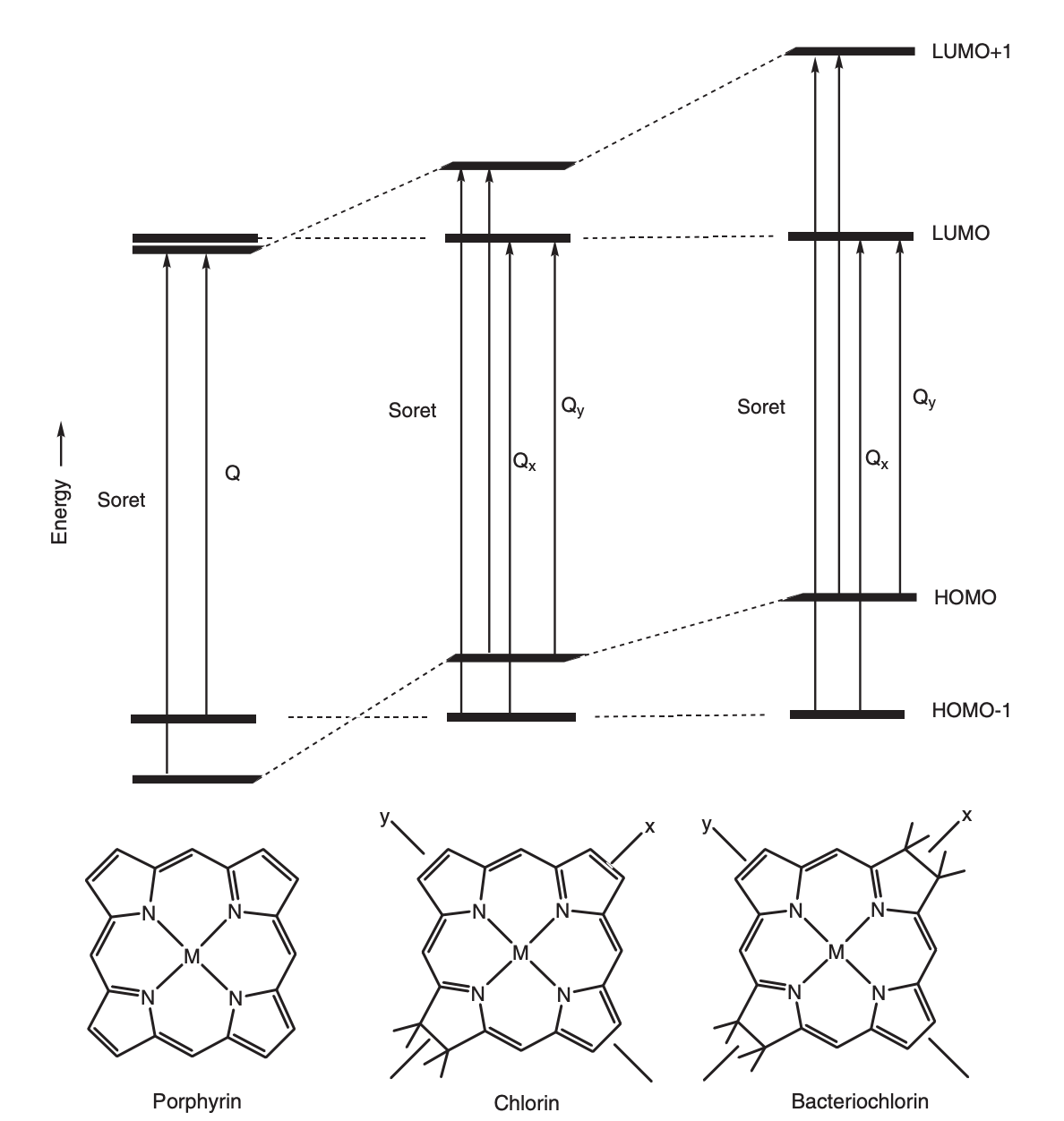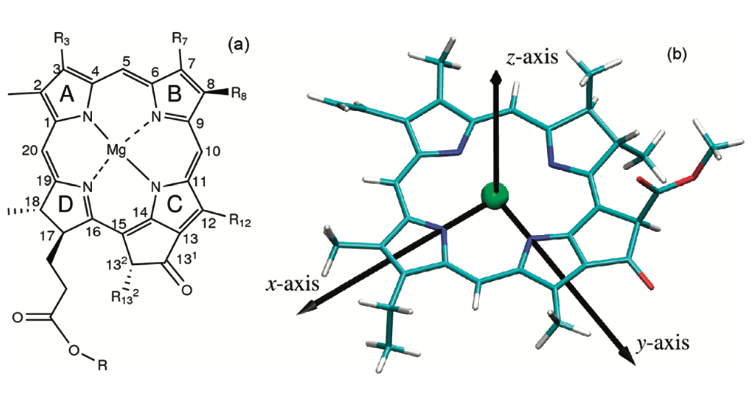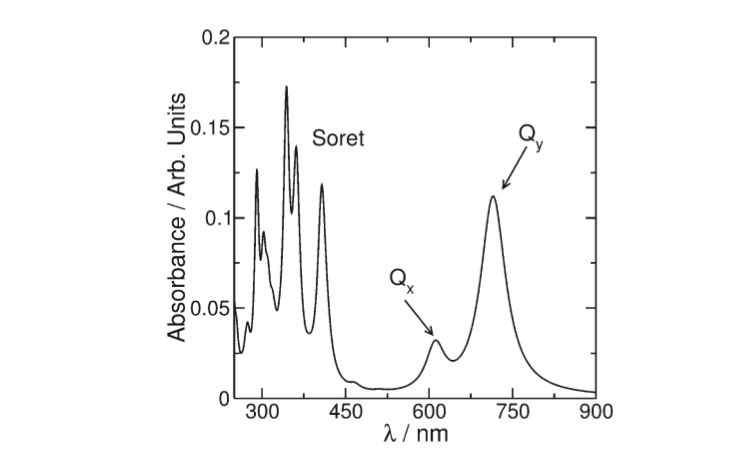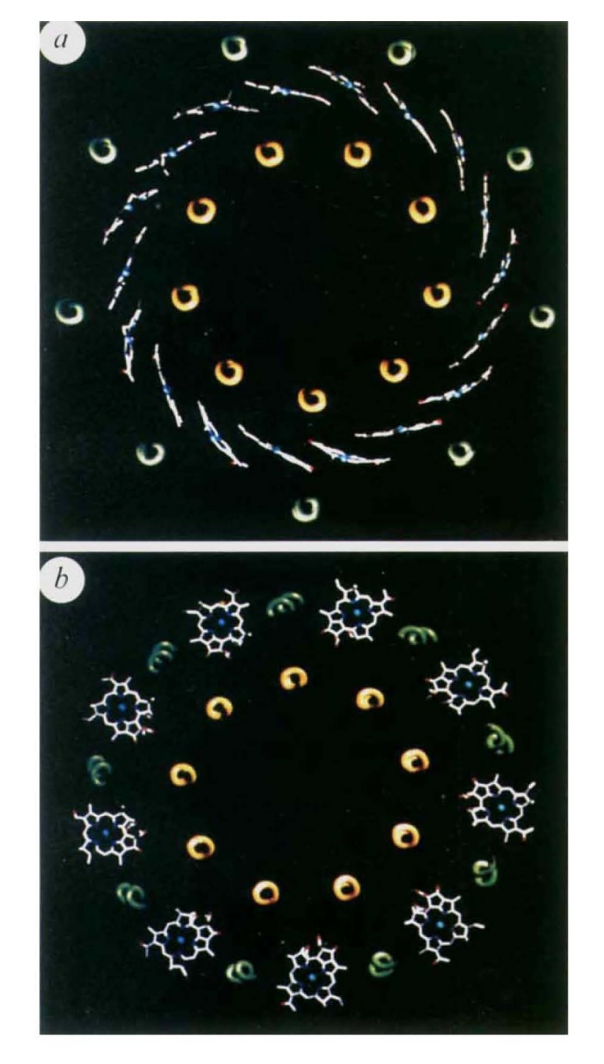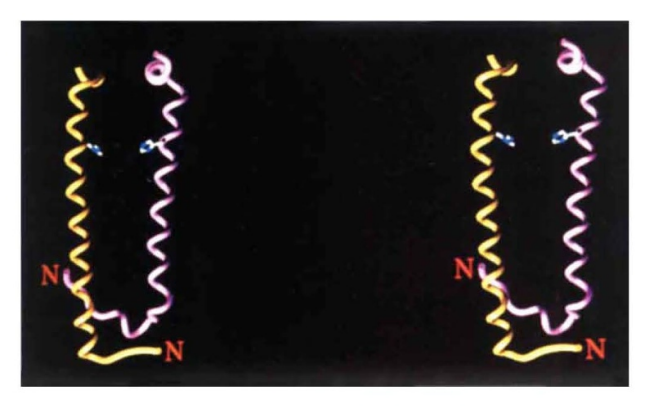User:Clara Costa D'Elia/Sandbox 1
From Proteopedia
(Difference between revisions)
| Line 5: | Line 5: | ||
==introduction== | ==introduction== | ||
| - | Photosynthesis | + | Photosynthesis is the main source of energy used by life on earth nowadays. "The beginning of photosynthesis starts with the absorption of sunlight by an arrangement of photosynthetic pigments embedded into a proteic matrix called the light harvesting (LH) antenna complexes. The excitation energy of |
| - | photosynthetic pigments is then transferred to the photosynthetic reaction center where it is converted into chemical energy. | + | photosynthetic pigments is then transferred to the photosynthetic reaction center where it is converted into chemical energy". |
.<ref> https://doi.org/10.1021/jp203826q </ref> | .<ref> https://doi.org/10.1021/jp203826q </ref> | ||
| - | . | + | Photosynthesis is divided in a few steps in a way that the antenna system does not do any chemistry, since it only works by transfering energy in the state of excited electrons between molecules. According to <ref>Blankenship, R. E. Molecular Mechanisms of Photosynthesis; |
| + | Blackwell Science Ltd.: Oxford, U.K., 2002.</ref> this is only possible due to a weak energetic coupling | ||
| + | of the antenna pigments, which are bound to proteins in highly specific associations. | ||
| + | |||
| + | Is it important to notice that this page describes the LHC II of purple bacterias, more specifically the one found in Rhodopseudomonas acidophila, which caries a similiar name but has nothing to do to the LHC II of plants and algae. | ||
| + | |||
| + | IN general Purple bacteria contain two types of antenna complexes, integral membrane proteins, the light harvesting complex I and II. LHI associates with the reaction center and is always present, constituting part of the "core complex" as explained by <ref>https://doi.org/10.1038/374517a0</ref>. | ||
| + | Light harvest complex to, also called LHII is located on the periphery of this core complex and its not always present, since its produced by the bacteria as an acessory complex depending on the avaiability of light leves encountered by the organism, in order to increase its range of absorption(Zuber & Brunisholz, 1991). Its important to notice that Both types of complex are built on a similar modular principle. | ||
| + | |||
| + | When purple bacteria are grown under anaerobic conditions they incorporate the photosynthetic apparatus described above into invaginated intracytoplasmic phospholipid membranes.<ref>https://doi.org/10.1038/374517a0</ref> | ||
| + | |||
| + | |||
| + | == Function == | ||
| + | |||
| + | As mentioned light-harvesting complexes are important for Purple bacterial to maximize the spectrum of light avaiable to them, modifyng the absorption properties of their chromophores; | ||
| + | |||
| + | In the LHC The proteins help to determine the disposition of the pigments, with, as it will be explained, end up influencing their absorption spectra, together with other factors such as inter-pigment geometries and their interactions with protein and membrane environments. | ||
| + | <ref> https://www.sciencedirect.com/science/article/pii/S002228360300024X?via%3Dihub </ref> | ||
| + | |||
| + | Pigmentwise, purple bacterias in general contain bacteriochlorophyll a or b, never both and in the case of Rhodopseudomonas acidophila, bacteriochlorophyll a, also abreviated to BChl a, associated with carotenoids, non-covalently bound to two low-molecular-weight hydrophobic apoproteins <ref>https://doi.org/10.1038/374517a0</ref> | ||
| + | |||
| + | Bacteriochlorophyll a It is the principal chlorophyll-type pigment in the majority of anoxygenic photosynthetic bacteria and acomodated several structural changes in comparinson to the typical clorophin pigments, specially regarded its symmetry, witch impose effects on its spectral properties. | ||
| + | [[Image:Bacteriochlorophylla.png]][[Image:Bacteriochlorophyllaabs.png]] <ref>Blankenship, R. E. Molecular Mechanisms of Photosynthesis; | ||
| + | Blackwell Science Ltd.: Oxford, U.K., 2002.</ref> | ||
| + | |||
| + | Acordig to the same autor, The spectra of photosynthethic pigments in gereral can be described by using the “four orbital” model. In this model there are for p molecular orbitals involved, simplified as HOMOs (highest occupied molecular orbitals) and LUMOs ( lowest unoccupied molecular orbitals). | ||
| + | [[Image:Orbitalss.png]] | ||
| + | The two lowest-energy transitions are called the Q bands, and the two higher-energy ones are known as the B bands. They are also commonly called Soret bands. | ||
| + | <ref>https://doi.org/10.1038/374517a0</ref>. The Qy transition dipole moments are responsible for the near infrared absorption by Bchl a molecules at generic wavelengths 800 nm and 850 nm, and for this reason these pigments are called B800 and B850.<ref> https://doi.org/10.1016/S0022-2836(03)00024-X</ref> | ||
| + | |||
| + | In order to further understand how the pigments respond to light excitation its important to visually the moleculas x and y axis. By convention, the y molecular axis is defined as the axis passing through the N atoms of rings A and C as show in the figure; | ||
| + | [[Image:Qy 2.png]]<ref> https://doi.org/10.1021/jp203826q </ref>. Acording to <ref>Blankenship, R. E. Molecular Mechanisms of Photosynthesis; | ||
| + | Blackwell Science Ltd.: Oxford, U.K., 2002.</ref> "The longest-wavelength transition is invariably polarized along the y | ||
| + | axis of the molecule and is therefore known as the Qy transition. This means that the absorption will be strongest if the electric vector of plane-polarized exciting light is parallel to the y molecular axis of the pigment. The exciting light couples to the p electrons of the | ||
| + | molecule and rearranges them somewhat during the transition". | ||
| + | This Qy transition causes a shift in electron density along the axis and its called a transition dipole. | ||
| + | Like other dipole moments, this dipole refers to a difference in charge from one region of a molecule to another. | ||
| + | <ref> https://bmc1.utm.utoronto.ca/~vijay/prototype_V12/physChem/molExcit/p08/index.html</ref> | ||
| + | |||
| + | ******* | ||
| + | The spectrum of photosynthetic pigments exhibits essentially two characteristic absorption bands | ||
| + | (Figure 2): one of them called the Soret band can be found in the | ||
| + | UV region and is a complex band composed of a large series of | ||
| + | electronic transitions. The other called Q is in the visible region | ||
| + | of the spectrum and is the most important for the photophysics | ||
| + | involved in the photosynthetic process | ||
| + | [[Image:QY_axis.png]]<ref> https://doi.org/10.1021/jp203826q </ref> | ||
| + | |||
| + | Important to understanding how these complexes trap energy is the degree of delocalisation of the lowest energy states between 850 nm and 870 nm.<ref> https://doi.org/10.1016/S0022-2836(03)00024-X</ref> | ||
| + | |||
| + | |||
| + | The delocalization energy is the extra stability a compound has as a result of having delocalized electrons. Electron delocalization is also called resonance. Therefore, delocalization energy is also called resonance energy. The resonance hybrid is more stable than any of its resonance contributors is predicted to be | ||
| + | |||
| + | Charge delocalization is a stabilizing force because it spreads energy over a larger area rather than keeping it confined to a small area. Since electrons are charges, the presence of delocalized electrons brings extra stability to a system compared to a similar system where electrons are localized. The stabilizing effect of charge and electron delocalization is known as resonance energy. | ||
| + | |||
| + | Since conjugation brings up electron delocalization, it follows that the more extensive the conjugated system, the more stable the molecule (i.e. the lower its potential energy). If there are positive or negative charges, they also spread out as a result of resonance. | ||
| + | |||
| + | <ref>https://chem.libretexts.org/Bookshelves/Physical_and_Theoretical_Chemistry_Textbook_Maps/Supplemental_Modules_(Physical_and_Theoretical_Chemistry)/Chemical_Bonding/Valence_Bond_Theory/Delocalization_of_Electrons</ref> | ||
| + | |||
| + | ==Energy transfer mechanism== | ||
| + | When a Bchl molecule is excited by light, its first excited singlet | ||
| + | state lasts for a few nanoseconds!. The light-harvesting system | ||
| + | must be able to transfer the absorbed energy to the reaction | ||
| + | centre in a shorter time than this. Some of the important features | ||
| + | that allow this to take place are revealed by the structure | ||
| + | reported here. | ||
| + | Previous biophysical studies (reviewed in ref. 1) have shown | ||
| + | that energy transfer within the LH2 complex can occur from the | ||
| + | BSOO to the BS50 BChl a molecules in 0.7 ps. Once the energy | ||
| + | reaches the BS50 molecules, it is rapidly transferred among them. | ||
| + | This is seen as an ultrafast depolarization of the excited state on | ||
| + | the 200-300 fs timescale. Energy transfer from LH2 to LHI | ||
| + | occurs in the 5-20 ps time range, but with LH2 alone the decay | ||
| + | of the S50 nm excited singlet state takes 1.1 ns. | ||
| + | The ring of BS50 Bchl a molecules acts rather like a 'storage | ||
| + | ring', with the excited state rapidly delocalized over a large area. | ||
| + | The delocalization is facilitated by a highly hydrophobic | ||
| + | environment which reduces the dielectric constant, allowing | ||
| + | coupling over large distances. The energy is then available for | ||
| + | transfer from any part of the ring to any neighbouring LHI | ||
| + | complex. It is clear from electron microscopy imaging of the | ||
| + | LHI complex 13 , and from a comparison of the primary | ||
| + | structures3 of the LH2 and LH I complexes, that the structure | ||
| + | of the LHI complex is similar to that of LH2 (with a larger | ||
| + | ring). With such a ring structure, there is no requirement for the | ||
| + | LHI complex to have a special orientation to receive energy | ||
| + | from the LH2 ring. Furthermore, because the BS75 Bchl a | ||
| + | molecules in LHI are liganded to homologous histidine residues, | ||
| + | as in LH2, it is likely that the BS50 and BS75 bacteriochlorophyll | ||
| + | rings will be at the same point in the membrane. The overall | ||
| + | effect will be to allow energy transfer from any LH2 to any LHI | ||
| + | complex that is within range, without regard to the orientation | ||
| + | of either complex. This reduction in the dimensionality of the | ||
| + | process will lead to a further kinetic gain. | ||
| + | Previous studies have shown that the carotenoid in this LH2 | ||
| + | complex acts as an efficient accessory light-harvesting pigment | ||
| + | (>50%)7. The excited singlet lifetime of carotenoids is usually | ||
| + | less than 10 pS8. Therefore, if energy transfer is to compete successfully with these rapid de-excitation processes, the carotenoid | ||
| + | must be located very close to the acceptor bacteriochlorophylls8, | ||
| + | as seen in the structure. | ||
| + | <ref>https://doi.org/10.1038/374517a0</ref> | ||
| + | == Structural highlights == | ||
| + | ######################################## | ||
| + | |||
| + | The chlorophylls all contain two major absorption bands, one in the blue or near UV region and one in the red or near IR region.The lack of a significant absorption in the green | ||
| + | region gives the chlorophylls their characteristic green or blue–green color. These absorption bands are pÆp* transitions,involving the electrons in the conjugated psystem | ||
| + | of the chlorin macrocycle. | ||
| + | Usually, purple bacteria contain two types of antenna complexes, both of which are | ||
integral membrane proteins. LHl, is intimately | integral membrane proteins. LHl, is intimately | ||
associated with the reaction centre forming the so-called 'core' | associated with the reaction centre forming the so-called 'core' | ||
| Line 17: | Line 124: | ||
LH2 complexes are produced in variable amounts according to the available light levels, the absorbance range of the particular LH2 (800 and 850, 800 and 820 nm), the temperature, and the bacterial species and strain (Zuber & Brunisholz, 1991). | LH2 complexes are produced in variable amounts according to the available light levels, the absorbance range of the particular LH2 (800 and 850, 800 and 820 nm), the temperature, and the bacterial species and strain (Zuber & Brunisholz, 1991). | ||
When purple bacteria are grown under anaerobic conditions they incorporate the photosynthetic apparatus described above into invaginated intracytoplasmic phospholipid membranes.<ref>https://doi.org/10.1038/374517a0</ref> | When purple bacteria are grown under anaerobic conditions they incorporate the photosynthetic apparatus described above into invaginated intracytoplasmic phospholipid membranes.<ref>https://doi.org/10.1038/374517a0</ref> | ||
| - | |||
| - | == Function == | ||
| - | light-harvesting complexes make possible for Purple bacterial to maximize the spectrum of light avaiable to them, modifyng the absorption properties of their chromophores; The energy absorbed is used in the bacteria photochemistry. | ||
| - | |||
| - | In the LHC The proteins determine the disposition of the pigments, therefore changing and influencing their absorption spectra. | ||
| - | The properties and times scales of energy transfer arise from the relative pigment interaction energies and pigment site energy disorder. These in turn are controlled by factors such as inter-pigment geometries and their interactions with protein and membrane environments. | ||
| - | <ref> https://www.sciencedirect.com/science/article/pii/S002228360300024X?via%3Dihub </ref> | ||
| - | |||
| - | The light-absorbing pigments, bacteriochlorophyll a (Bchl a) and carotenoids, | ||
| - | are non-covalently bound to two low-molecular-weight hydrophobic apoproteins, a and p. The native complexes are oligomers | ||
| - | of these components. <ref>https://doi.org/10.1038/374517a0</ref> | ||
Each individual light-harvesting complex is composed of oligomers of short peptides (α and β) with associated pigments (Hawthornthwaite & Cogdell, 1991). αβ apoproteins with their non-covalently bound carotenoid and bacteriochlorophyll (Bchl ) pigments form the multi-subunit complexes LH1 and LH2 | Each individual light-harvesting complex is composed of oligomers of short peptides (α and β) with associated pigments (Hawthornthwaite & Cogdell, 1991). αβ apoproteins with their non-covalently bound carotenoid and bacteriochlorophyll (Bchl ) pigments form the multi-subunit complexes LH1 and LH2 | ||
| + | |||
| + | Some of the bacteriochlorophyll pigments in LH2 are spectrally distinct from others. | ||
| + | This is easily seen in the absorption spectrum of the complex, which exhibits two bands | ||
| + | centered at 800 and 850 nm (Fig. 5.11). The structure of the complex provides a clear explanation for these two classes of pigments. The pigments that absorb at 800 nm form a | ||
| + | ring with the plane of the bacteriochlorophyll molecules parallel to the plane of the | ||
| + | membrane that the complex is embedded in and are known as B800 pigments. The B800 | ||
| + | pigments are rather weakly coupled to each other and are at a distance of approximately | ||
| + | 21 Å from each other. Their spectral properties are largely consistent with their being | ||
| + | independent molecules. | ||
| + | The pigments that absorb at 850 nm are arranged quite differently.Each subunit complex has two molecules of bacteriochlorophyll arranged as a closely coupled dimer, with | ||
| + | the plane of the B850 bacteriochlorophyll molecules approximately perpendicular to the | ||
| + | plane of the membrane.These dimers become a band of 16 or 18 pigments when the subunit complexes assemble into the LH2 complex, and the absorbance is shifted to 850 nm by exciton and pigment–protein interactions, so that they are known as B850 pigments. | ||
| + | This band of B850 pigments are all strongly exciton-coupled together, so excitations are | ||
| + | effectively delocalized over much or all of the entire band, rather than being effectively | ||
| + | localized in a single pigment for a short while and then hopping to another pigment,as is | ||
| + | the case with the B800 pigments. | ||
| + | The carotenoid molecules have an extended conformation and lie generally perpendicular to the plane of the membrane, with close approach (3.4–3.7 Å) to both the B800 | ||
| + | and the B850 pigments. | ||
== Structure == | == Structure == | ||
Revision as of 13:41, 14 June 2022
Light Harvesting Complex II
| |||||||||||
References
- ↑ Hanson, R. M., Prilusky, J., Renjian, Z., Nakane, T. and Sussman, J. L. (2013), JSmol and the Next-Generation Web-Based Representation of 3D Molecular Structure as Applied to Proteopedia. Isr. J. Chem., 53:207-216. doi:http://dx.doi.org/10.1002/ijch.201300024
- ↑ Herraez A. Biomolecules in the computer: Jmol to the rescue. Biochem Mol Biol Educ. 2006 Jul;34(4):255-61. doi: 10.1002/bmb.2006.494034042644. PMID:21638687 doi:10.1002/bmb.2006.494034042644
- ↑ https://doi.org/10.1021/jp203826q
- ↑ Blankenship, R. E. Molecular Mechanisms of Photosynthesis; Blackwell Science Ltd.: Oxford, U.K., 2002.
- ↑ https://doi.org/10.1038/374517a0
- ↑ https://doi.org/10.1038/374517a0
- ↑ https://www.sciencedirect.com/science/article/pii/S002228360300024X?via%3Dihub
- ↑ https://doi.org/10.1038/374517a0
- ↑ Blankenship, R. E. Molecular Mechanisms of Photosynthesis; Blackwell Science Ltd.: Oxford, U.K., 2002.
- ↑ https://doi.org/10.1038/374517a0
- ↑ https://doi.org/10.1016/S0022-2836(03)00024-X
- ↑ https://doi.org/10.1021/jp203826q
- ↑ Blankenship, R. E. Molecular Mechanisms of Photosynthesis; Blackwell Science Ltd.: Oxford, U.K., 2002.
- ↑ https://bmc1.utm.utoronto.ca/~vijay/prototype_V12/physChem/molExcit/p08/index.html
- ↑ https://doi.org/10.1021/jp203826q
- ↑ https://doi.org/10.1016/S0022-2836(03)00024-X
- ↑ https://chem.libretexts.org/Bookshelves/Physical_and_Theoretical_Chemistry_Textbook_Maps/Supplemental_Modules_(Physical_and_Theoretical_Chemistry)/Chemical_Bonding/Valence_Bond_Theory/Delocalization_of_Electrons
- ↑ https://doi.org/10.1038/374517a0
- ↑ https://doi.org/10.1038/374517a0
- ↑ https://doi.org/10.1038/374517a0
- ↑ https://doi.org/10.1038/374517a0
- ↑ https://doi.org/10.1016/S0022-2836(03)00024-X
- ↑ https://bmc1.utm.utoronto.ca/~vijay/prototype_V12/physChem/molExcit/p08/index.html
- ↑ https://doi.org/10.1021/jp203826q
- ↑ https://doi.org/10.1021/jp203826q
- ↑ https://doi.org/10.1016/S0022-2836(03)00024-X
- ↑ https://chem.libretexts.org/Bookshelves/Physical_and_Theoretical_Chemistry_Textbook_Maps/Supplemental_Modules_(Physical_and_Theoretical_Chemistry)/Chemical_Bonding/Valence_Bond_Theory/Delocalization_of_Electrons
- ↑ https://doi.org/10.1038/374517a0
